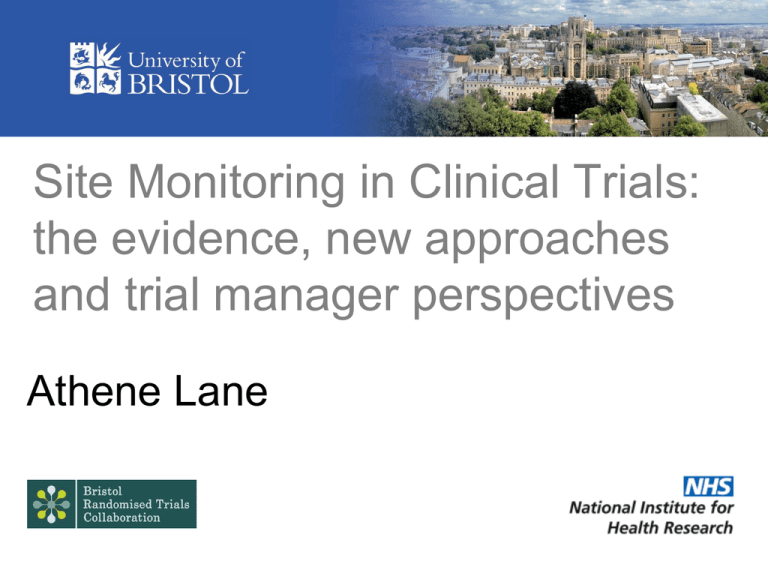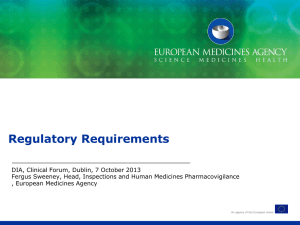Site Monitoring in Clinical Trials
advertisement

Site Monitoring in Clinical Trials: the evidence, new approaches and trial manager perspectives Athene Lane Overview: presentation/discussion • Rationale for site monitoring • Systematic review of on-site monitoring systems • New approaches to site monitoring • Peer review site monitoring system (PRIME) • Evaluation of PRIME in the ProtecT trial • Trial managers experiences and practices Monitoring rationale: ICH- GCP • The rights of participants are protected • Data is accurate, complete & verifiable (SDV) • Conduct adheres to the protocol and GCP • ‘Generally there is a need for on-site monitoring, before, during and after the trial’ • European Clinical Trials Directive based on ICHGCP for all IMP trials became UK law in 2004 Trial monitoring systems MHRA Ethics TSC DMC CI & TMG Regulators & Sponsors CTU Protocol & SOPs Site monitoring Training Data checks Trial conduct & data collection Trial sites Systematic review of onsite monitoring systems Rhiannon Macefield, Andrew Beswick, Jane Blazeby PRISMA flow diagram Records from other sources n= 28 (Hand search of CT/CCT/CCT, referenced in other papers , personal knowledge) Records from database search (Embase: 529, Medline: 536) Removed duplicates n = 678 Records screened n = 678 Records excluded n = 526 Full-text articles assessed n =152 Excluded (n = 123) Safety monitoring or central monitoring e.g. radiotherapy QA, no details/methods, not full paper, unavailable (2) Included n = 29 Articles included n = 57 Publication characteristics (n) 1 RCT of site monitoring intervention – stopped early Individual trial reports (30, 26 trials) Heart disease (33%), cancer (23%) Group or organisation descriptions (21) 16 groups: e.g. USA NCI cooperative groups, EORTC and pharmaceutical industry Cost simulations (2) and surveys (3) Published monitoring structures • Frequency: multiple visits to all sites (where stated) • • Range from 2 months to 3 years Monitors varied: • sponsors, ‘independent evaluators’, DSMB/TSC, coordinating centre staff, trial coordinators, data managers, clinical investigators, CRA • 1 to 8 monitors, typically up to 3 Site monitoring activities • Review trial documents • View site facilities/clinic tours • Walk through/discuss procedures with site staff • Interview site staff • Observe trial procedures • Often inadequately described: “A full onsite review” Site monitoring assessments • Consent verification • SDV and data management • Protocol adherence • Drug accountability • Safety monitoring and ethical approvals • Site operation including accrual and retention • Staff training Feedback and reports • Some exit interviews to outline findings and problems (NCI cooperative groups) • Report templates (NIDA CTN, NHBLI, VA) • Written report distributed to: • Local investigator/site director • Sponsors/funders • CI and trial coordinator • TSC and performance review committees Benefits of site monitoring (5) • Identified problems: procedural errors/data inconsistencies • Issues resolved quicker, e.g. increased recruitment (2) • Improved protocol adherence and GCP compliance (3) • Interactions of staff between sites and central staff • Shared best practice between sites • Opportunities for training Site monitoring disadvantages • Costs: typically for one day but up to four days • EORTC = £600 direct costs in 1991 • NIDA £1000 direct costs in 2009 • Staff time regarded as a major cost but not measured • 50% of site staff in a survey found visits annoying Summary and ongoing research • Most publications from non-commercial trials & groups • No consistency in systems • Little evaluation of costs and benefits to trials • Abstract in Clinical Trials2010;7:428 (paper under review) • New trials of site monitoring: • Pharma standard v risk-adapted monitoring trials: • France: OPTIMON (V Journot) CC Trials 2011 32: 16. • Germany: ADAMON (O Brostaneau) C Trials 2009 6:585. New approaches • Monitoring workshop of best practice in 2012 • N West HTMR, C Tudur-Smith & other hubs • Effective and efficient monitoring research • CTTI & FDA in USA, M Landray, CTSU, Oxford • FDA draft guidance on risk adapted monitoring • ECRIN: QA working party on monitoring • V Journot, Bordeaux • [MHRA risk-adapted processes M Ward] Peer Review Intervention for Monitoring and Evaluating Sites Athene Lane, Rhiannon Macefield, Julia Wade, Liz Down, Sue Bonnington, Pete Holding, Teresa Lennon, Amanda Jones, Liz Salter, David Neal, Freddie Hamdy & Jenny Donovan PRIME structure Peer reviewers TM & 2 site nurses (from 5) Annual PRIME visits to all sites (1-2 d) SOP & report template Exit meeting & problem solving Report to CIs & local PI PRIME Intervention & Evaluation Component Objective PRIME activity Hours Orientation Training Orientation & trial progress meeting Site performance Performance Site recruitment and attrition rates 0.5 Protocol adherence GCP Observation, feedback & meetings 6 Data collection GCP Observation of CRF completion 1 Safety monitoring GCP Review process & documentation 0.5 Documentation GCP Site file review 1 Training Training Site staff training discussion 0.5 Site organisation Performance Coordinating centre communication 0.5 Trial conduct observation • Recruitment & follow-up appointments • Individual feedback given to site staff • Errors difficult to identify otherwise: • Local exclusion criteria • Weight taken with shoes on Evaluation of PRIME • • • • • ProtecT: prostate cancer treatment trial ISRCTN20141297, HTA funded trial Three years of PRIME site reports analysed Resource use [Survey of site nurses] Findings by component and year Training Performance GCP adherence PRIME benefits and costs • Benefits: site performance gains, e.g. • Increased radiotherapy CRF return (65%) • Study cohesion & communication • Identifies individual and study training needs • “Useful for ensuring everything is in order! Good for sharing good practice” (staff survey) • Annual costs: staff time (32-56 d) & £5,600 Summary • • • • • PRIME visits annually to all trial sites Standardises trial conduct & good practice Site staff focus including as peer reviewers Improves GCP compliance Performance gains PRIME recent research • Used in two other studies: • SFP Cymru (SEWTU) • DUTY (BRTC & SEWTU) • • • • PRIME SOP adapted for these studies Benefits from site visits and training Currently seeking additional trials? Evaluate in other trials, including costs • Any questions? • Group work and discussion • Athene.lane@bristol.ac.uk Group work and discussion • 1. Survey on site monitoring practice • 2. Small groups for 15 minutes to discuss: • • • • Your experiences of on-site monitoring List benefits and disadvantages Other ways to monitoring trial conduct at sites? What sort of trials could benefit from PRIME? • 3. Feedback main points to the whole group











